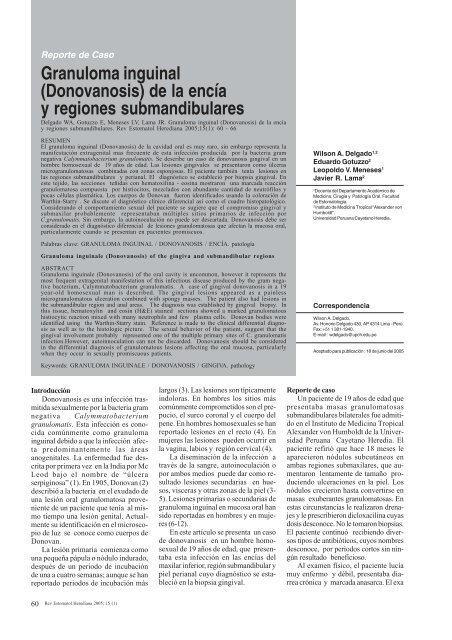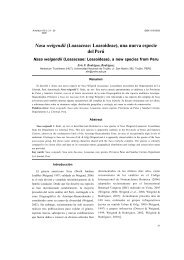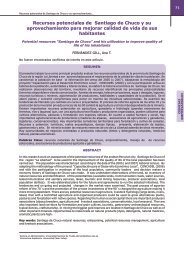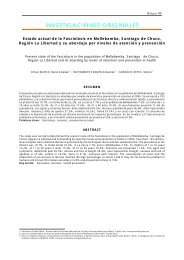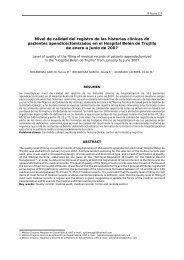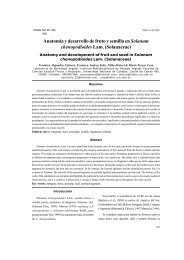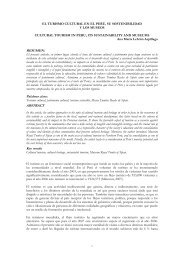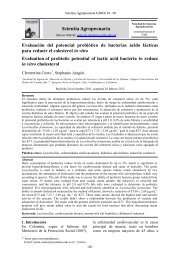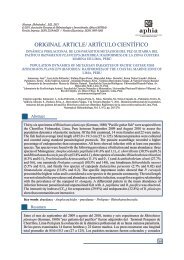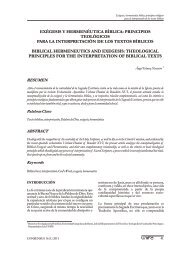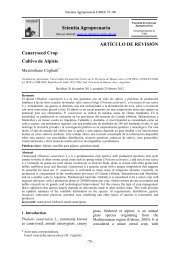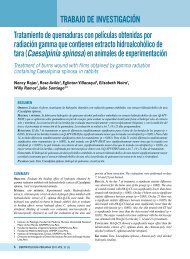Granuloma inguinal (Donovanosis) - Universidad Peruana ...
Granuloma inguinal (Donovanosis) - Universidad Peruana ...
Granuloma inguinal (Donovanosis) - Universidad Peruana ...
- No tags were found...
Create successful ePaper yourself
Turn your PDF publications into a flip-book with our unique Google optimized e-Paper software.
<strong>Granuloma</strong> <strong>inguinal</strong> ...to, pequeños cuerpos ligeramente basofílicos.Las secciones teñidas con PASy Ziehl-Neelsen fueron negativas, perola coloración de Warthin-Starry revelódentro de los histiocitos la presencia depequeños bastones de color negro(Fig. 7). Este hallazgo conjuntamentecon la historia del paciente estableció eldiagnóstico de donovanosis.FroticesDespués de haber establecido eldiagnóstico histopatológico, se tomaronfrotices de la lesiones submandibularesy gingivales, en los cuales la coloraciónde Warthin-Starry mostró la presenciade cuerpos de Donovan dentro de loshistiocitos (Fig. 8).Otras biopsiasLas biopsias tomadas de lasregiones perianal y submaxilaresmostraron cambios histopatológicossimilares a los observados en los tejidosgingivales. La coloración de Warthin-Starry en estos tejidos también revelócuerpos de Donovan.TratamientoEl paciente fue hidratado y recibióuna dieta apropiada suplementada conVitamina B12 y ácido fólico. La infecciónfue tratada con Doxiciclina en dosis de100mg dos veces al día administradadurante 80 días. Las lesiones de pieldesaparecieron lentamente, dejandocicatrices fibrosas en las regionessubmandibulares (Fig. 9) y perianal. Laslesiones gingivales curaron sin dejarcicatriz(Fig. 10).Discusión<strong>Donovanosis</strong> o granuloma <strong>inguinal</strong>es una infección crónica, de progresiónlenta moderadamente contagiosaproducida por el microorganismodenominado Calymmatobacteriumgranulomatis.Las lesiones usualmente se localizanen la piel de la región <strong>inguinal</strong> yanorectal. Afecta también los genitalesy la mucosa oral. Ocasionalmente otraspartes del cuerpo pueden estar comprometidas.Clínicamente se caracteriza porel desarrollo de masas carnosas, ulceradas,granulomatosas, indoloras quecrecen lentamente. El diagnósticodefinitivo se establece por detección delos cuerpos de Donovan en frotices oen biopsias tomadas de las zonasafectadas. Los cuerpos de Donovanestán dentro del citoplasma de loshistiocitos y se revelan usando coloracionesespeciales.Los frotices pueden ser teñidos conlas técnicas de Giemsa, Leishman,Wright or Warthin- Starry. En lassecciones de tejidos la tinción deGiemsa y particularmente las tincionesde plata como la de Warthin-Starryesson de gran utilidad para mostrar almicroorganismo. La coloración deWarthin-Starry muestra claramente loscuerpos de Donovan como pequeñosbastones oscuros que miden de 0.5-07um por 1-1.5 um (3).El granuloma <strong>inguinal</strong> rara vez evolucionaa una infección sistémica. Sólo 25% de casos o menos afecta la región<strong>inguinal</strong>, por ello Lal y Nicholas (1)propusieron el término “granulomaFigura 7. Tinción de Warthin-Starry quemuestra a los cuerpos de Donovan comoestructuras bacilares dentro de loshistiocitos. (x 400).Warthin-Starry stain showing Donovanbodies as rod structures inside the histiocytes.(x 400).Figura 9. Las lesiones de la piel curarondejando cicatrices fibrosas. Control a los dosaños.Skin lesions healed leaving fibrous scars.Two years follow up.donovani”. Los interesados en todoslos aspectos de esta infección puedenrevisar los excelentes trabajospublicados por Hart (3) y Sowmini(13).Las lesiones extragenitales sondefinidas como aquellas lesiones que seencuentran localizadas fuera de las áreasanogenital e <strong>inguinal</strong> (3). Se ha estimadoque ocurren en cerca del 6% de los casos(14-17). Estas pueden corresponder ainfección primaria, debido a autoinoculaciónvía los dedos del paciente o adiseminación hematógena. En niños, laslesiones han sido atribuidas a contactodirecto con padres enfermos (18,19). Lamucosa oral es la zona extragenital máscomúnmente afectada (14,17).En unestudio realizado en la India, 50 (5.8%) de858 pacientes con donovanosismostraban compromiso oral. En 12 deestos pacientes, la enfermedad produjolesiones en la piel del cuello y de lamandíbula (2).En nuestro paciente las lesionesmayores estaban localizadas en la piel dela región submandibular y en la encíaFigura 8. Frotis de la encia con coloracion deWarthin-Starry, que muestra un histiocito decitoplasma amplio conteniendo los cuerposde Donovan. Alrededor se distinguenneutrofilos y algunos linfocitos. (x400).Smear of the gingiva showing a largehistocyte containing Donovan bodies. Manyneutrophils and some lymphocytes aroundthe histiocyte. (Warthin-Starry, x400).Figura 10. Las lesiones orales curaron sindejar secuela. Control a los dos años.Oral lesions healed without scarring. Twoyears follow up.62Rev Estomatol Herediana 2005; 15 (1)
Delgado WA, Gonzalo E, Meneses LV, Lama JR.inferior. El paciente nunca consultóacerca de las lesiones ubicadas en lasregiones perianal y gingival. Elcompromiso submandibular se presentócomo masas granulomatosas, simétricas,indoloras, clínicamente eran muysemejantes a las lesiones de donovanosisque se desarrollan en el perineo (20,21).Las lesiones de la cavidad oralestaban confinadas a toda la encíavestibular y lingual inferior y semanifestaron como ulceracionesmicrogranulomatosas combinadas conáreas de apariencia esponjosa. Lasencías sangraban fácilmente durante lamasticación y a la menor manipulación.De acuerdo a la presentación clínica, seconsideraron los siguientes diagnósticodiferenciales : paracoccidiodomicosis,histoplasmosis y tuberculosis oralprimariaEl diagnóstico definitivo se estableciópor estudio histopatológico de biopsiastomadas de la lesión gingival. Lassecciones de H&E mostraban una marcadareacción histiocítica granulomatosacon numerosos neutrófilos y escasonúmero de células plasmáticas ylinfocitos. Los cuerpos de Donovanfueron identificados dentro de loshistiocitos usando la coloración deWarthin-Starry. La apariencia esponjosade la encía, correspondía histológicamentea la acumulación superficial degrandes histiocitos que producía atrofiadel epitelio.Cuando se utiliza la coloración deWarthin-Starry es muy importanterecordar que la Klebsiellarhinoscleromatis también se tiñe conesta técnica. La forma y tamaño de estosdos microorganismos son similarescuando se usa esta coloración (22).Recientemente, ha sido propuesta lareclasificación del C.granulomatiscomo Klesiella granulomatis debidoal hecho que el microorganismo muestraun alto grado de identificación conespecies de Klebsiella que sonpatógenos para los humanos (23).La diferenciación entre donovanosisy rinoescleroma se establece considerandoque rinoescleroma afecta la narizy también el tracto respiratorio superiore inferior, siendo el compromiso oral muyraro y cuando esto ocurre las lesionesestán localizadas en el paladar blandoy duro, encías y labio superior. Por otrolado, histológicamente se observanagregados compactos de histiocitos decitoplasma espumoso de aparienciaxantomatosa, conteniendo algunos deellos varios núcleos (células deMikulicz), además existe un densoinfiltrado de células plasmáticas ynumerosos cuerpos de Russell(22,24).Los neutrófilos no son tannumerosos como en donovanosis.Un aspecto notorio de este caso esla ausencia de lesiones en el resto de lacavidad oral, a pesar del extensocompromiso de la encía inferior y laprolongada duración de la infección.También es importante recalcar que nohubo compromiso sistémico, aúncuando, las lesiones de donovanosispersistieron por varios meses. Eltratamiento con doxiciclina fue efectivo,dejando solamente secuelas cicatrizalesen la piel pero no en la encía.Puesto que el paciente tenía tambiéncompromiso de la región anal, es difícilprobar que las lesiones gingivales osubmaxilares representaban manifestacionesprimarias o secundarias. Elcomportamiento sexual del paciente másbien sugiere que las tres áreasanatómicas afectadas representabanmúltiples sitios primarios de infecciónpor C.granulomatis. Sin embargo, nopuede descartarse completamente laposibilidad que las lesiones submaxilaresy orales hayan sido el resultadode autoinoculación.El presente reporte es un excelenteejemplo de manifestación extragenital dedonovanosis. Debido a que la cavidadoral representa el sitio extragenital máscomunmente afectado y siendo laslesiones típicamente crónicas yasintomáticas, en el diagnóstico diferencialde lesiones granulomatosas de lamucosa oral, es fundamental considerardonovanosis. Esto es parti-cularmenteimportante cuando en la historia delpaciente no se obtienen datos epidemiológicosrelacionados con infeccionesgranulomatosas endémicas y el pacientees sexualmente activo. La biopsia y elfrotis teñidos con coloracionesespecíficas son fundamentales paraestablecer el diagnóstico correcto.<strong>Granuloma</strong> <strong>inguinal</strong>e (<strong>Donovanosis</strong>) ofthe gingiva and submandibular regionsDelgado WA, Gotuzzo E, MenesesLV, Lama JR. <strong>Granuloma</strong> <strong>inguinal</strong>e(<strong>Donovanosis</strong>) of the submandibularregion and gingiva. Rev EstomatolHerediana 2005; 15(1):<strong>Donovanosis</strong> is a sexually transmittedinfection produce by the gram negativebacterium Calymmatobacteriumgranulomatis. The disease was firstdescribed by Mc Leod in India underthe name of “serpiginous ulcers” (1).<strong>Donovanosis</strong> is better known as granuloma<strong>inguinal</strong>e, since this infection predominantlyaffects the anogenital areas.In 1905, Donovan (2) described thepresence of what are now called“Donovan bodies” in the exudate froman oral granulomatous lesion of a patientwho also had a genital lesion.The primary lesion starts as a smallpapule or indurated nodule, usually occurringafter an incubation period of oneto four weeks; however, longer periodsof incubation have been reported (3).Lesions are characteristically painless.In men the anatomical sites more commonlyinvolved are the prepuce, coronalsulcus and penile shaft. Rectal lesionshave been reported in homosexualmen (4). In women, labial, vaginal andcervical lesions may occur (4).Dissemination of donovanosisthrough hematogenous spread, self- inoculationor both, can result in bone,visceral and skin lesions (3,5). There areseveral reports of oral lesions of granuloma<strong>inguinal</strong>e found in both men andwomen. Primary or secondary lesionsaffecting the oral mucosa have beenreported (6-12).A case of donovanosis involvingthe mandibular gingiva, submandibularregion and perianal skin in a 19-yearold homosexual man is described.Case reportA 19 year old man with bilateralsubmandibular granulomatous masses63
<strong>Granuloma</strong> <strong>inguinal</strong> ...was admitted to the Tropical MedicineInstitute Alexander von Humboldt of thePeruvian University Cayetano Heredia.Eighteen months before he had developedsubcutaneous nodules in both submandibularregions which had been increasingslowly in size and had becomeulcerated. Later the nodules developedchronic exuberant granulomatousmasses. At this time, the lesions weredrainage and dicloxacillin was prescribedfor treatment. Biopsy of the lesions werenot performed. He continued receivingmany short courses of different types ofantibiotics without benefit.Upon examination the patient appearedseverely ill and extremelydebilitated.He had chronic diarrhea andmarked anasarca. Abdominal examinationrevealed ascitis. The liver, spleenand lymph nodes could not be palpated.The scrotum presented marked edema.The patient stated he was a crossdressinghomosexual sex worker sincethe age of 14. He has had multiple sexpartners and rarely used condoms. Healways lived in Lima and denied travelto the peruvian jungle or highlands.There was no history of tuberculosis.Skin findingsAt the anal region a painless ulceratedmass of irregular form, approximately3 cm. in diameter was found.Symmetrical large granulomatous exuberantmasses were present in the submandibularregion bilaterally. The surfacewere ulcerated with serosanguinousdischarge. The borders of themasses were sharply demarcated fromthe adjacent skin. The lesions were friable(Fig.1, 2). No cervical lymphadenopathywas detected.Oral findingsBoth vestibular and lingual aspectsof the mandibular gingiva appearedspongy and hyperplastic. In some areas,the texture of the surface wasmicrogranulomatous showing areas ofulceration and bleeding (Fig. 3). Themucosa adjacent to the root remnant ofthe first right lower molar bled easily(Fig. 4). The gingival lesions were painlessand the patient was not aware ofthem. The rest of the oral mucosa includingthe tongue and tonsils werenormal. Apart from the molar remmantthe rest of the teeth were in good condition.A panoramic radiograph did notshow bone alterations.Laboratory studiesThe following abnormalities werefound :Hematocrite 19% (N: 45%)Erythrocyte sedimentation rate58% mm/h (N: 1 -10mm/h)Neutrophils 83% (55-70%)Lymphocytes 12% (25-33%)Total serum proteins4.83 g/dl (N: 6.1-7.9 g/dl)Serum albumin1.5 g/dl (N: 3.5-4.8 g/dl)Serum globulin3.33 g/dl (N: 2.6-3.1 g/dl)Serum vitamin B12180.0 pg/ml (N: 200-1000 pg/dl)Serum folic acid2 ng/ml (N: 3.0-25.0 ng/dl)The results of two HIV ELISA tests,VDRL and HBsAg were negative. Gramstain of the smears of the skin lesionsshowed isolated gram (+) coccus andacid-fast stain was negative.Gingival biopsyThe hematoxilin and esosin (H&E)sections obtained from two vestibulargingival biopsies showed accumulationsof large histiocytes with pale cytoplasmlocated immediately below the epitheliumwhich occupied the entire lamina propria(Fig. 5). Together with this cells manyneutrophils and few plasma cells and lymphocyteswere present (Fig. 6). Ulceratedareas were observed. Inside the cytoplasmof the histiocytes slightly basophilicsmall bodies could be detected athigher power. Sections stained with PASand acid fast stains were negative, butthe Warthin-Starry stain disclosed manyblack rod-shaped bodies inside the histiocytes(Fig.7). This finding together withthe history of the patient established thediagnosis of donovanosis.SmearsOnce the histopathologic diagnosiswas established, smears from thesubmandibular lesions were takenwhich were stained with Warthin-Starrystain. This study was also positive forDonovan bodies. (Fig.8).Other biopsiesSpecimens obtained from the skinof the submandibular and anal regionsdemonstrated similar histopathologicfeatures to the gingival tissues. TheWarthin-Starry stain was also positivefor Donovan bodies.TreatmentThe patient was hydrated and providedan adequate diet. He was treatedwith supplements of folic acid and vitaminB12. Doxycycline 100mg twice a daywas administered for eighty days. Theskin lesions disappeared slowly leavingfibrous scars in the perianal and submandibularregions (Fig. 9). The oral lesionshealed without scarring (Fig. 10).Discussion<strong>Donovanosis</strong> is a mildly contagious,chronic, slowly progressive infectionproduced by the microorganism Calymmatobacteriumgranulomatis. Lesionsare usually localized to anorectal and<strong>inguinal</strong> skin. It also affects the genitaliaand oral mucosa. Occasionally, otherparts of the body can be involved. Clinically,it is characterized by the developmentof a velvety or beefy, red, granulomatouspainless ulceration that expandsslowly. Definitive diagnosis isestablished by detection of Donovanbodies in smears and biopsies takenfrom affected areas. Donovan bodies aredisclosed inside the cytoplasm of histiocytesusing special stains. Thesmears can be stained with Giemsa,Leishman, Wright or Warthin-Starrytechniques. In tissue sections, Giemsastain and particularly silver stains suchas Warthin-Starry demostrate the microorganism.Warthin-Starry stainclearly shows Donovan bodies as darkrod-shaped bodies measuring 0.5 - 0.7um x 1-1.5 um (3).<strong>Granuloma</strong> <strong>inguinal</strong>e is seldomsystemic.Only 25% or less of cases affectthe <strong>inguinal</strong> region. Therefore, theterm “granuloma donovani” was pro64Rev Estomatol Herediana 2005; 15 (1)
Delgado WA, Gonzalo E, Meneses LV, Lama JR.posed by Lal and Nicholas (1). Thoseinterested in all aspects of this infectionrefer to the comprehensive reviewspublished by Hart (3) and Sowmini (13).Extragenital lesions are defined asthose lesions located outside the <strong>inguinal</strong>or anogenital areas (3). They areestimated to occur in about 6% of cases(14-17). They may represent a primaryinfection, may occur by autoinoculationor by hematogenous spread.. In children,lesions have been attributed todirect contact with their diseased parent(18,19). The oral mucosa representsthe most commonly affected extragenitalzone (14,17). In a large Indian study,50 (5.8%) of 858 patients withdonovanosis had oral involvement.In 12of these patients, the disease producedlesions of the skin of the neck or jaw (2).In our patient the major lesions werelocated in the skin of the submandibularregions and in the mandibular gingiva.The patient never sought consultationnor complained of the anal andgingival lesions. The submandibularinvolvement appeared as large symmetricalpainless, granulomatousmasses which resembled the characteristicdonovanosis lesions affecting theperineum (20,21).In the present case , the lesions inthe oral cavity were confined to themandibular gingiva and appeared aspainless microgranulomatous ulcerationscombined with spongy areas. Theaffected gums bled easily during masticationand on gentle contact. Given theoral clinical presentation, conditions consideredin the differential diagnosisincluded paracoccidiodomycosis, histoplasmosis,and primary oral tuberculosis.The definitive diagnosis was establishedby histopathologic study ofbiopsies obtained from the gingival lesions.Hematoxilyn-eosin stained sectionsshowed a marked granulomatoushistiocytic reaction with numerous neutrophilsand limited numbers of plasmacells and lymphocytes. Donovan bodieswere identified inside the histiocytesusing Wharthin-Starry stain. Thespongy appearance of the gingiva correspondedhistologically to superficialaccumulation of large histiocytescoupled with epithelial atrophy.When using the Warthin-Starrystain, it is very important to rememberthat Klebsiella rhinoscleromatis can alsobe stained with this technique. Theshape and size of both microorganismsare similar when they are disclosed withWarthin-Starry stain (22). Recently, C.granulomatis has been proposed to bereclassified as Klebsiella granulomatisdue to the fact that this microorganismshows a high level of identity with Klebsiellaspecies pathogenic to humans (23).In order to differentiate donovanosisfrom rhinoscleroma, it is necessary toconsider that rhinoescleroma affectsthe nose but also the upper and lowerrespiratory tracts . Involvement of oralmucosa is rare, and when this occurslesions are located in the soft and hardpalate,upper lip and maxillary gingiva.Histologically consists of closely aggregatedfoamy macrophages of xanthomatousappearance, some of them multinuclear(Mikulicz´s cells), a denseplasmacytic infiltrate and Russell bodieswithin the plasma cells (22,24). Neutrophilsif present are not numerous asthey are in donovanosis.A remarkable aspect of this case, isthe absense of lesions in the rest of theoral cavity in spite of the extensive mandibulargingival involvement and theduration of the infection. Also, no systemiclesions were detected. Although,the lesions of donovanosis persistedfor several months, treatment withDoxycycline was effective and apartfrom the skin scars, no sequellae remainedin the affected gums.Since the patient also had involvementof the anus, it is difficult to provethat the lesions of the gingivae or of thesubmandibular regions represented primaryor secondary manifestations ofdonovanosis. The sexual behavior ofthe patient suggests that the three anatomicaffected areas represented multipleprimary sites of C. granulomatisinfection. However, the posibility thatthe submandibular and oral lesionswere the result of autoinnoculation cannot be discarded.The present report is a good exampleof the extragenital manifestationsof donovanosis. Since the oral cavity isreported to be the most commonly affectedextragenital site and the lesionsare typically chronic and asymptomatic,it is necessary to consider donovanosisin the differential diagnosis of granulomatouslesions affecting the oral mucosa.This is particularly important whenepidemiological data related to endemicinfections is absent in the history ofsexually active patients. The biopsy oforal lesions and the use of specificstains are fundamental to establishingthe correct diagnosis.Referencias bibliograficas /References1. Lal S, Nicholas C. Epidemiologicaland clinical features in 165 cases ofgranuloma <strong>inguinal</strong>e. Br J Vener Dis1970; 46:461-3.2. Rajam RV, Rangiah PN.<strong>Donovanosis</strong>. WHO Monographseries N° 24,Geneva, 1954.3. Hart G. <strong>Donovanosis</strong>. Clin Infect Dis1997; 25:24-32.4. Ballard RC. Calymmatobacteriumgranulomatis (<strong>Donovanosis</strong>,granuloma <strong>inguinal</strong>e). In: MandellGL, Bennett JE, Dolin R. Editors.Principles and practice of infectiousdiseases. New York: ChurchillLivingstone; 1995.p. 2210-3.5. Barnes R, Masood S, Lammert N,Young RH. Extragenital granuloma<strong>inguinal</strong>e mimicking a soft-tissueneoplasm: a case report and reviewof the literature. Human Pathol1990;21:559-61.6. Bhaskar SN, Jacoway JR, FleuchausPT. Oral surgery-oral pathologyconference N° 15 Walter Reed ArmyMedical Center. Primary granulomavenereum of the gingiva. Oral SurgOral Med Oral Pathol 1965; 20:535-41.7. Garg BR, Lal S, Bedi BM, RatnamDV, Naik DN. <strong>Donovanosis</strong> (granuloma<strong>inguinal</strong>e) of the oral cavity. BrJ Vener Dis 1975; 51:136-7.8. Rao MS, Kameswari VR, Ramulu C,Reddy CR. Oral lesions ofgranuloma <strong>inguinal</strong>e. J Oral Surg1976; 34: 1112- 4.9. Brain P. <strong>Granuloma</strong> <strong>inguinal</strong>e with65
<strong>Granuloma</strong> <strong>inguinal</strong> ...extensive oral involvement. S Afr Med J1951; 25:581-2.10. Felman YM, Nikitas JA. Sexuallytransmitted diseases of the oral cavity:part II. Cutis 1982; 30: 185-6.11. Coovadia YM, Steiberg JL,Kharsany A. <strong>Granuloma</strong> <strong>inguinal</strong>e(donovanosis) of the oral cavity. Acase report. S Afr Med J 1985; 68:815-7.12. Doddridge M, Muirhead R.<strong>Donovanosis</strong> of the oral cavity.Case report. Aust Dent J 994;39:203-5.13. Sowmini CN. <strong>Donovanosis</strong>. In:Holmes K, Mårdh P. InternationalPerspectives on Neglected SexuallyTransmitted Diseases. New York McGraw - Hill Book Company;1983.p.205-217.14. Rajam RV, Rangiah PN, Anguli VC.Systemic donovanosis. Br J VenerDis 1954; 30: 73-80.15. Sehgal VN, Sharma NL, BhargavaNC, Nayar M, Chandra M. Primaryextragenital disseminated cutaneousdonovanosis. Brit J Dermatol 1979;101:353-6.16. Brigden M, Guard R. Extragenitalgranuloma <strong>inguinal</strong>e in NorthQueensland. Med J Aust 1980; 2:565-7.17. Spagnolo DV, Coburn PR, CreanJJ, Azadian BS. Extragenital granuloma<strong>inguinal</strong>e (<strong>Donovanosis</strong>) diagnosedin the United Kingdom:a clinical, histological, and electronmicroscopical study. J ClinPathol 1984; 37:945-9.18. Scott CW, Haroer DM, Jason RS,Helwig EB. Neonatal <strong>Granuloma</strong> Venereum.Am J Dis Child 1953; 85:308-15.19. Banerjee K. <strong>Donovanosis</strong> in a childof six months. J Indian Med Assoc.1972; 59:293.20. Rothenberg RB. <strong>Granuloma</strong> InguinaleIn: Fitzpatrick TB, Eisen AZ,Wolff K, Freedberg IM, Austen KF,editors. Dermatology in GeneralMedicine. New York Mc Graw-Hill,Inc;1993.p.2757-59.21. Brazin SA. Nontreponemal venerealinfection In: Moschella SL,Hinley HJ, editors Dermatology .Philadelphia WB Saunders;1985.p.870-89.22. Sedano HO, Carlos R, Koutlas IG.Respiratory scleroma: a clinicopathologicand ultrastructural study.Oral Surg Oral Med Oral Pathol OralRadiol Endod 1996,81:665-71.23. Carter JS, Bowden FJ, Bastian I,Meyers GM, Sriprakash KS, KempDJ. Phylogenetic evidence for reclassificationof Calymmatobacteriumgranulomatis as Klebsiellagranulomatis comb. nov. Int J SystemBacteriol 1999; 49:1695-1700.24. Von Lichtenberg F. Pathology of InfectiousDiseases. New York: RavenPress; 1991.p.160-161.66Rev Estomatol Herediana 2005; 15 (1)


